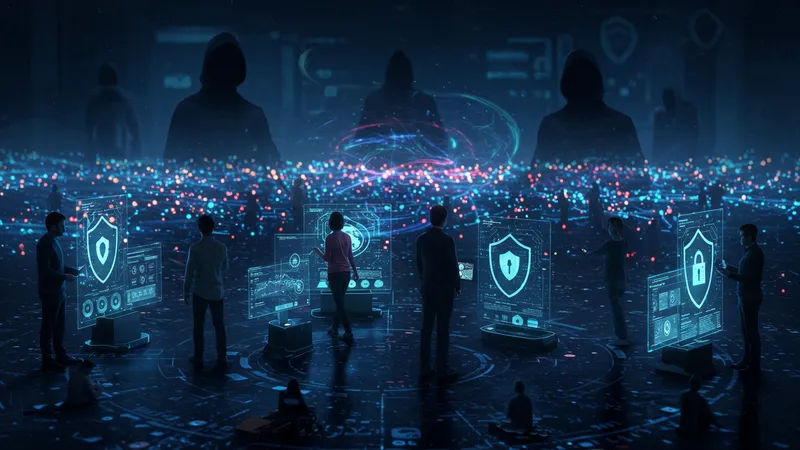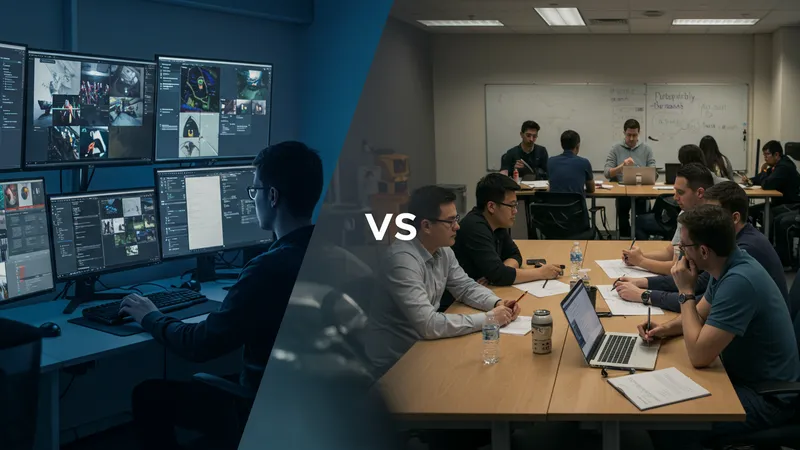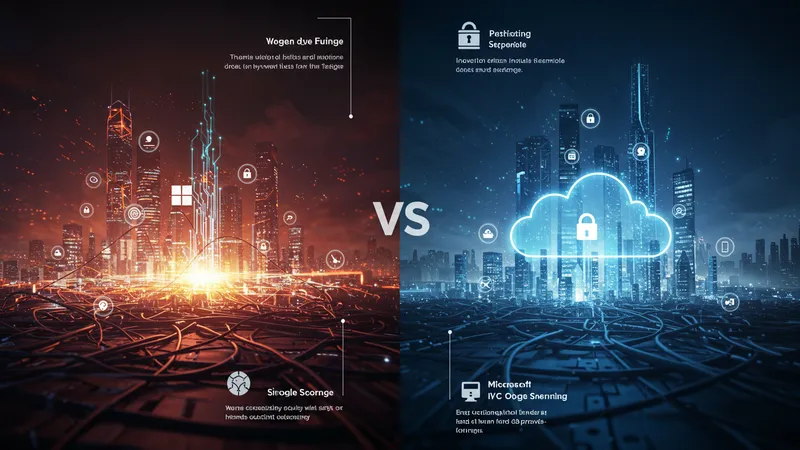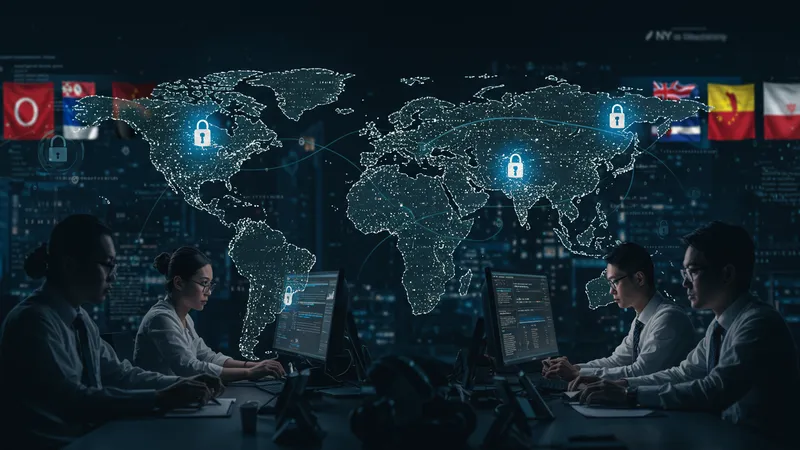

In a world where hackers seem to be multiplying faster than any anti-virus can handle, cybersecurity education is not just for the tech-savvy—it’s a vital lifeline for everyone. The shocking truth? Many of the top courses reveal that 92% of web-based attacks can be prevented with proper knowledge.
Now, this revelation isn’t just a tech nerd’s fantasy. With the surge in remote work, learning cybersecurity has become more essential than ever. The potential for massive data breaches looms over businesses like never before, pushing cybersecurity education to center stage. But how much does the general public really understand about these courses?

What if I told you that the current structure of most cybersecurity courses might be fueling future security problems? It sounds crazy, but hear me out. While many courses promise quick fixes and instant expertise, insiders are worried that the real complexities of today's threats are being glossed over for simplicity. But that’s not even the wildest part…
Consider this: some cybersecurity experts argue that current educational modules are missing critical information, leaving gaping holes in the foundation of a student's understanding. Meanwhile, hackers are becoming more sophisticated, working at speed and with tools that are far superior to many firms’ defenses. Ambiguity in course content is just the start of a much bigger issue. What happens next shocked even the experts…
Cybersecurity education has often been seen as a silver bullet in the digital age. However, a startling revelation is that roughly 70% of professionals in the field believe that current training programs are inadequate. They warn that these courses focus too heavily on theory while ignoring practical skills. This oversight creates a chasm between academic knowledge and real-world application, leaving graduates unprepared for the rigorous demands of the industry. Yet, there's one more nuance that surprisingly few people discuss…

The pressure to release courses quickly has led to a flood of subpar content. Students enter these programs with high hopes but find themselves stuck with outdated information and generic assessments. Such gaps result in graduates who are ill-prepared for actual threats — an ironic twist, considering they're supposed to defend against these exact issues. But there's something more alarming that's only just coming to light.
Many institutions lack the resources to update their programs rapidly in response to emerging threats, often due to financial constraints. This effectively creates a lag as educational content struggles to catch up with the fast-evolving field of cybersecurity. Students are left to navigate this maze without a map, potentially leading to catastrophic vulnerabilities in the systems they were trained to protect. Preparing students for real-world scenarios certainly isn’t as straightforward as it seems…
Some top-tier programs are thankfully breaking away from old paradigms, focusing on evolving threats and cutting-edge defensive strategies. They're integrating adaptive learning models and simulations of attack scenarios to bridge that critical ‘theory vs. practice’ gap. Yet, this innovative approach raises new questions about accessibility and cost. What you read next might change how you see this forever.
While classic hacking tactics are well-documented and extensively taught, a surge in unorthodox cyber threats is emerging in the shadows. Experts are starting to realize that traditional educational approaches might not adequately prepare students for these elusive dangers. Phishing scams now often bypass standard defenses thanks to AI-driven personalization. Meanwhile, Internet of Things (IoT) gadgets have opened a back door to many networks, a digital nightmare that most courses still overlook.

Among the lesser-known threats, “fileless” malware is causing significant concern. Unlike conventional malware that hides in programs, fileless malware operates from within existing, trusted applications, evading detection with disturbing ease. It's a stealth tactic that makes the skills learned in a typical cybersecurity course seem almost archaic by comparison. Yet, this is only scratching the surface of what’s really happening out there…
Sensing these vulnerabilities, some specialized training institutions are beginning to weave these emerging threats into their curriculum. They're inventing new teaching paradigms tailored to these insidious tactics, making regular course updates imperative. However, this advancement isn’t spreading fast enough, leaving a majority of institutions enveloped in a false sense of security. But what will happen when the next major breach occurs?
While digital transition promises efficiency, it also flings doors wide open for cybercriminals, evolving faster than most courses can teach. Eyes are turning toward alumni from more agile, experimental programs who seem better equipped for this relentless battle. But how much longer can traditional schools ignore this tide before they're swept away? The next chapter might be a turning point.
One surprising twist in the realm of cybersecurity education is the ongoing debate over the effectiveness of online learning versus in-person training. While digital courses offer unparalleled convenience and reach, they may sacrifice the depth and engagement experienced in a physical classroom setting. Certain soft skills, critical for security roles, are often best honed through face-to-face interactions.

Online platforms have championed flexibility, with tools like virtual labs and live tutorials offering hands-on experience, albeit remotely. These platforms have turned personal desks into learning hubs, democratizing access. Yet, those who’ve experienced both forms argue that digital courses often lack the intensity and immediacy needed to simulate an actual cyberattack scenario. But this is not the only aspect that makes online teaching contentious…
There’s also the issue of retention. Studies suggest students enrolled in online courses may retain less information than those attending in-person sessions due to reduced accountability and increased distractions. This emerges as a problem given the high stakes involved in cybersecurity. If learners can’t effectively absorb and apply defensive strategies, they risk underperformance when it truly counts. What implications does this have for future cybersecurity pros?
Despite these challenges, a hybrid model — one that marries the best of both worlds — may offer a path forward. Capitalizing on the flexibility of online courses while incorporating mandatory, high-stakes, in-person assessments could foster a more holistic skill set. However, as models evolve, schools face growing pains in implementing these programs effectively. Who will rise to set the new standard?
While general cybersecurity courses cover a broad spectrum of topics, there's an increasingly urgent call for specialized paths. The cybersecurity landscape is segmented into niches like ethical hacking, network defense, and digital forensics. Each requires unique competencies that general courses may overlook. Institutions beginning to offer these laser-focused specializations are seeing increased enrollment as students pursue targeted expertise.

Ethical hacking, in particular, has become a hot ticket. It empowers students with the ability to anticipate and preempt cyber threats by understanding the hacker’s mind. Training involves legal vulnerabilities, penetration testing, and application security, equipping learners to implement strategic defenses before threats manifest. The practical impact of this niche learning is becoming unmistakable. Yet, why haven’t more institutions adopted this approach?
Furthermore, digital forensics demands meticulous attention to detail, seeking specialists who can dissect incidents and trace cyber footprints back to their origin. With the rise of digital crimes, this specialization becomes ever more crucial. However, the exhaustive nature of forensic study often demands additional time and resources, leading many students to opt-out. Would informing about its critical role alter this trend?
Network defense further emphasizes each layer of protection, crafting strategies to reinforce infrastructure against intrusions. Institutions are slowly expanding their curriculum to accommodate these needs, but the rate at which this transition happens is fraught with institutional inertia. These specialties are catalysts for change in cybersecurity education, suggesting that a seismic shift might just be on the horizon.
In today’s digitally charged environment, the investment in cybersecurity education doesn’t seem to align with the growing threats. Governments and private sectors allocate vast resources to technology and defense, yet the education system, the bedrock of future protection, receives a fraction of this support. A jarring truth is that cybersecurity training often relies on outdated notions of funding priorities.
Some are advocating for an overhaul of financial approaches to education. By attributing greater value to this sector, they argue, the ripple effects would be immense. Stronger educational infrastructures could cultivate experts who are better equipped for the cyber frontline. But the urgency seems lacking when immediate returns aren’t visible. How can this skewed perspective be corrected?
As breaches grow in scale and frequency, the financial sector fears the looming possibility: that insufficiently educated professionals will lead to catastrophic losses. Yet, stakeholders often adopt a reactive stance, waiting for breaches to spark change, rather than proactively enhancing education. Nevertheless, a breakthrough might emerge from an unexpected quarter. Could student initiatives lead the charge?
Some universities are witnessing a rising tide of student-led cybersecurity clubs and hackathons. These activities encourage peer learning and provide real-world problem-solving experiences that supplement formal education. Their success underscores an untapped potential within students poised to innovate from the ground up. What if these grassroots efforts become the key to reversing educational underinvestment?
As cybersecurity continues to command global attention, tech giants like Microsoft and Google are asserting their dominance not only in technology but education as well. They have taken strides in crafting educational content that parallels their advanced security systems. Initiatives like Google’s Cybersecurity Certificate aim to provide accessible learning with industry-standard knowledge.

Microsoft, on the other hand, has partnered with educational platforms to roll out comprehensive courses focusing on cloud security and IoT, areas often neglected in traditional curriculums. They are advocating a hands-on approach, emphasizing skill where theory has long been the standard. It’s changing how the digital landscape perceives cybersecurity expertise.
While these initiatives bring about opportunities, they also introduce complexities. Tech-driven curriculums might sideline other educational providers, potentially monopolizing market dynamics. Critics argue that this could stifle academic diversity and limit critical discussions on cybersecurity’s nuanced issues. But how will smaller players respond to this challenge?
Some smaller institutions have begun collaborating, pooling resources to create competitive curriculums that can rival tech giants. A key tactic is fostering innovative pedagogies that emphasize critical thinking over rote learning. There’s a growing sentiment that transforming cybersecurity education into a more inclusive and representative discipline could be the road to future-proofing our systems.
Imagine immersing yourself into a digital battlefield where you can test your cybersecurity skills against simulated attacks. Virtual reality (VR) training is no longer just a tech fantasy—it’s becoming a reality. Educators are recognizing VR's potential to revolutionize the way we train future cyber defenders.
VR offers an engaging and dynamic environment where students can experiment without real-world consequences. This method allows learners to witness the immediate impact of their defensive moves in real-time, making abstract concepts tangible. It shifts the paradigm from passive to interactive learning.
However, as the technology edges toward mainstream adoption, questions about its feasibility and cost linger. Many institutions struggle to afford such cutting-edge advancements, worrying that they will be left behind as others accelerate. Yet, early adopters are reporting significant improvement in student engagement and retention. So will this cutting-edge tech become the norm?
Educational institutions that choose to invest in VR are leveraging partnerships with tech companies to subsidize costs and expand access. This collaboration is pivotal as the technology spreads its roots across the educational landscape. If these partnerships prove successful, traditional learning modules might soon become a relic of the past.
Legislation plays a pivotal role in shaping the direction of cybersecurity education, yet its involvement remains surprisingly muted. As new cyber threats emerge, up-to-date educational frameworks are essential; yet, many countries are slow to integrate cybersecurity into their national curricula. It’s an oversight with far-reaching implications.

Cybersecurity isn’t just a technical issue but an economic and national security concern. As such, lawmakers are beginning to recognize the need for comprehensive policies that mandate baseline cybersecurity skills from early education onward. These initiatives paint a promising picture but are often mired in bureaucratic red tape. But is legislation alone enough to spur change?
The few leaders who’ve successfully implemented educational mandates are witnessing noteworthy achievements. Their programs have generated improved awareness, making students better equipped to handle digital challenges. However, without consistent updates and investment, even these programs risk becoming obsolete. What other strategies could policymakers deploy?
Collaboration with tech companies and educators could propel legislative efforts in crafting content that maintains relevance. By reimagining partnerships across sectors, legislation can turn challenges into opportunities for growth, rethinking cybersecurity education for future generations. Could these actions lay the foundation for a more secure digital society?
While cybersecurity education forms the backbone of our defense against cybercrime, public awareness remains an unsung hero in this battle. High-profile security breaches have made headlines, but everyday individuals often remain oblivious to basic digital hygiene practices. This disconnect represents a critical gap that can’t be plugged merely through traditional education channels.

Effective public awareness campaigns can equip citizens with the knowledge to protect themselves. Spurred by partnerships between private corporations, governments, and non-profits, these initiatives use mass media to educate the public on evolving threats. These campaigns underscore cybersecurity's role as an integral part of daily life.
However, crafting a resonant message that reaches diverse audiences is fraught with challenges. Misinformation and apathy towards cybersecurity often dilute the impact of campaigns. Tailoring content that resonates at a personal level becomes crucial. What if harnessing technology itself created more engaged audiences?
Interactive digital content, quizzes, and gamified experiences have shown promise in capturing public interest. Innovative messaging further backed by real-time feedback can stimulate engagement like nothing else. If well-executed, these strategies could galvanize public action on an unprecedented scale. It’s a game-changer in cybersecurity awareness.
Resilience, the capacity to anticipate, withstand, and recover from cyber incidents, is a cornerstone of effective cybersecurity education. Yet, too often, resilience training is treated as an afterthought rather than a primary objective. This oversight places systems and data at risk, undermining the very purpose of education in this field.

Building resilience involves more than just understanding threats; it requires strategic thinking, contingency planning, and the agility to adapt under pressure. These skills are just as vital as technical prowess. Yet, educational systems frequently underemphasize them, focusing more on current vulnerabilities than on dynamic response measures.
To address this gap, some institutions are adopting a systemic approach by integrating resilience into all aspects of their curriculum. Collaborative projects, simulated attack recoveries, and real-time crisis management exercises embed resilience into the educational process, preparing students for real-life challenges. But what more can be done to embrace comprehensive resilience training?
Global exchange programs and partnerships with industry leaders can enhance resilience education by pooling insights and expertise. As threats transcend borders, cross-cultural learning experiences can provide unique perspectives on problem-solving and mitigation techniques. These inclusive approaches could become the new blueprint for cybersecurity education's future.
The latest frontier in cybersecurity education may lie in the personalized learning journeys of students. Embracing data analytics and artificial intelligence, new educational models tailor content to individual learning styles and needs. This approach promises to transform conventional teaching methodologies, offering a unique and customized path for each learner.

Personalized learning leverages adaptive algorithms that adjust course material based on a student’s progress and performance. This real-time customization ensures that information is delivered at just the right complexity and pace, maximizing engagement and retention. How could these innovations reshape the future workforce?
As institutions begin to embrace this shift, some are developing platforms that use gamification to fuel motivation, transforming dry concepts into interactive challenges. These personalized ecosystems foster an environment where learners navigate cyber labyrinths, armed with tools irresistible to digital natives. But what challenges do they face?
Although promising, these systems require significant investment in technology and analytics infrastructure. Despite these hurdles, early adopters are already witnessing substantial improvements in student outcomes. If this trend continues, the next wave of cybersecurity professionals might be forged in a way that fundamentally alters industry standards.
As cyber threats evolve at a breakneck pace, countries find themselves in a race not unlike an arms race, pushing significant resources into training the best cybersecurity experts. Competition among nations has ramped up as they vie for dominance in this pivotal field. The clock is ticking, with the stakes higher than ever before.

While countries like the United States and China are pouring substantial funds into national cybersecurity programs, others lag due to financial constraints and policy inaction. Some nations have chosen to invest in scholarship and exchange programs to attract top talent, but is this enough to maintain competitiveness in the global arena?
Amid these dynamics, certain smaller countries have emerged as innovative leaders by placing a heavy emphasis on creativity and flexible thinking in education. They have successfully nurtured talent through bootcamps and workshops that focus on emergent technological applications. But can these pioneering efforts outpace the giants’ resources?
The next phase of this competition will involve leveraging artificial intelligence and machine learning to conduct national-security programs and educational curriculums. As geopolitical tensions simmer, the battle for cyber supremacy won’t just be won in board rooms or on the battlefield, but in classrooms across the globe.
The entrepreneurial spirit is making waves in cybersecurity education, as startups reengineer conventional learning paradigms. By adopting a market-oriented approach, these innovators are challenging old norms and injecting fresh perspectives into the traditional curriculum. How is this entrepreneurial surge reshaping the landscape?

Driven by demand for ultra-relevant skill sets and faster educational models, startups are crafting bootcamps and microcourses that promise competency in record time. These offerings push beyond theory, equipping students with hands-on knowledge that reflects industry needs. Yet, critics question whether this rapid-fire style sacrifices depth for speed. What does that mean for long-term knowledge retention?
Meanwhile, the startup culture emphasizes continuous real-time feedback cycles and peer-to-peer engagement, fostering a community-driven learning atmosphere. This decentralized model encourages students to initiate projects and explore uncharted territories, creating an ecosystem that mirrors real-world collaborative environments. How does this influence readiness for professional roles?
As this movement gains momentum, traditional institutions are watching closely, some even partnering with startups to integrate their innovative methodologies. If this trend persists, the distinction between conventional education and entrepreneurial innovation may blur, altering the future of how cybersecurity professionals are shaped.
The journey through cybersecurity education reveals a landscape as complex and layered as the threats it aims to defend against. But one truth remains evident: adapting to change is not just a strategy but a necessity. Innovators, educators, and policymakers must work in harmony, or risk falling behind in a game that shows no signs of slowing down. Share this story and take action in your corners of influence as the world of cybersecurity presses forward. The clock is ticking.